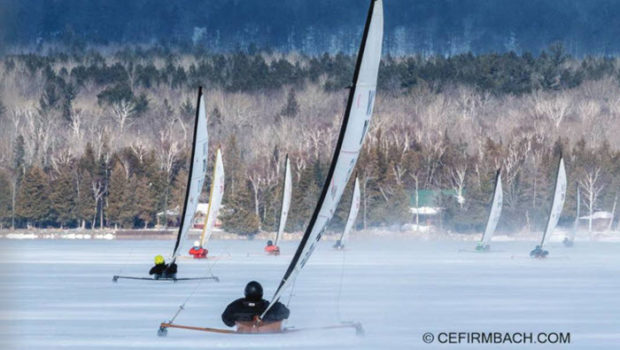Mast tech: Going from straight to bendy >> Scuttlebutt Sailing News
Published on January 1st, 2023
Watching a DN iceboat sail is to witness radical mast bend, but it had not always been that way. During his term in 1992-1993, Past Commodore Bob Schumacher and class officers began to address the issue of DN mast specifications by instituting an experimental mast program.
This article records how wood and aluminum masts evolved into various combinations of glass, carbon, and epoxy that we see today.
THE PROBLEM
Bob Schumacher: When you have a single race on sticky ice in 20 mph of wind and over five masts fail, you have a problem. When competitors bring two masts out to the start line because they don’t trust their mast to survive, you have a problem. When you are racing and have to avoid broken mast remains on the ice, you have a problem. When competitors with aluminum masts are seen between races straightening bends out of their masts, you have a problem.
THE PROBLEM WITH ALUMINUM
Jeff Kent, in his article for July 2011 Seahorse Magazine, identified the issue with aluminum masts:
“…a soft aluminum rig would bend to leeward beneath the hounds and absorb gusts. Although it looked bizarre this proved quite fast and also made the boat more forgiving to handle. Unfortunately, these softer aluminum rigs had a limited life span as the material wasn’t able to handle the repeat demands placed on it by the dynamic nature of the DN. It was also not possible to fine-tune the bend characteristics.”
THE SOLUTIONS
Bob Schumacher: There were many opinions about a solution. Change cross-section dimensions, cut slots in aluminum mast luff tubes to make them easier to bend, remove the wood requirement, make wood veneer masts, change the hound position, etc.
After talking to many sailors, there was no clear solution to making a durable, reasonably priced mast that was competitive but did not have a competitive advantage that would obsolete all existing masts. While some thought we were trying to solve a non-existent problem, we pushed forward, sometimes a very hard push.
Without a firm solution, we came up with the idea of the experimental mast program, allowing all class members to develop masts and race with them to test and show that they might have a solution.
EXPERIMENTAL MAST PROGRAM RULES
Bob Schumacher: We were firm in some rules:
1. The mast overall dimension rules would not change. We did want a narrower section that would give an aerodynamic advantage.
2. Minimum weight rules would apply to try and prevent high-end, lightweight, and expensive materials from being used.
3. A balance point requirement to prevent a light mast with a lead brick in the bottom.
4. All masts would have to be registered with the class, and have an experimental mast sticker issued by the class.
5. All builders would have to share what they were building.
After the experimental period, the rest is history. The mast rules were changed, with many builders selling masts in the $1000 range. Unfortunately, over the years, more carbon has been used than we had hoped, and the costs have gone up considerably. But overall, the new mast rules have been a huge success.
For additional details, click here.
Related Posts
By accepting you will be accessing a service provided by a third-party external to https://oc3anclub.com/




